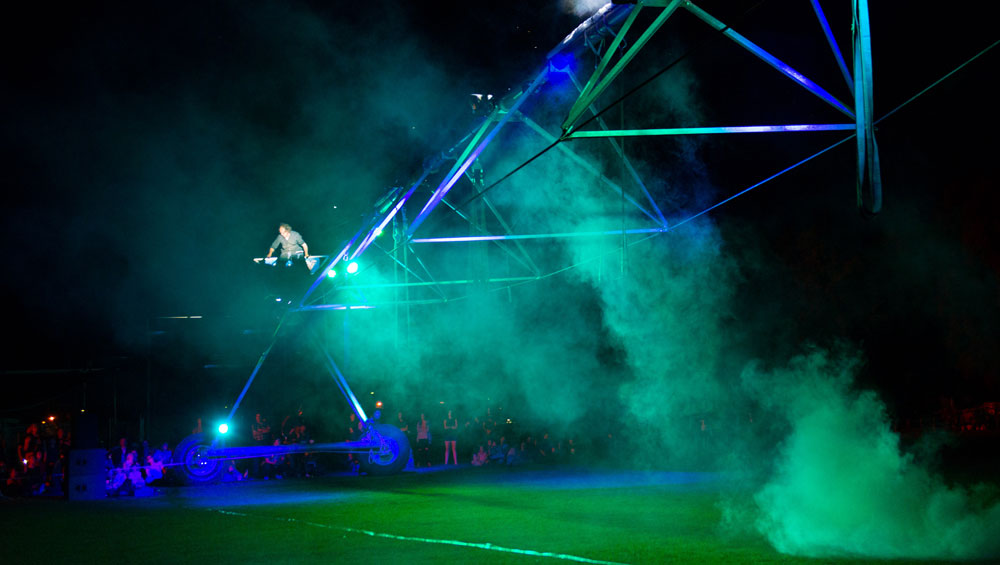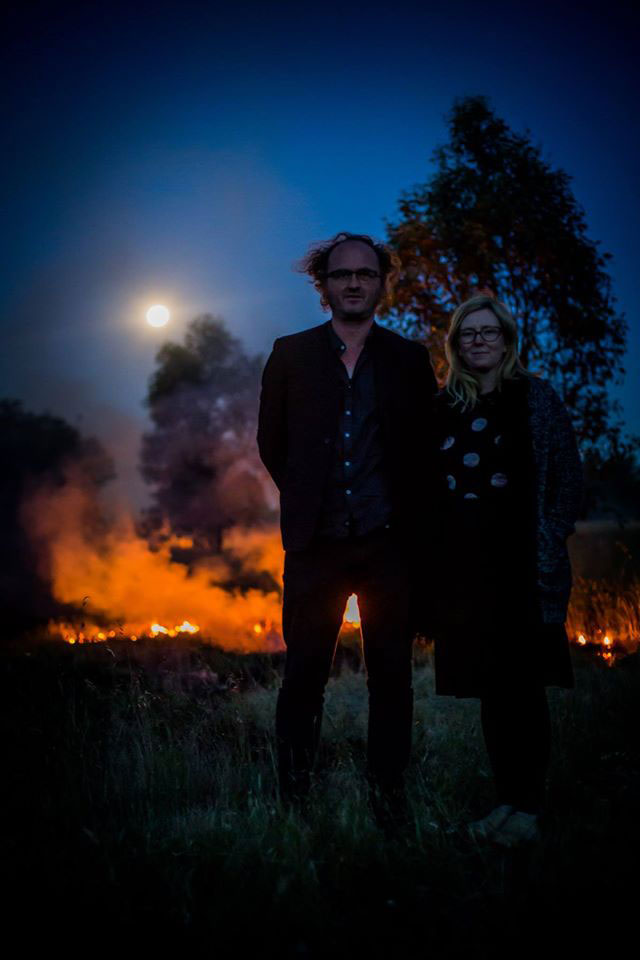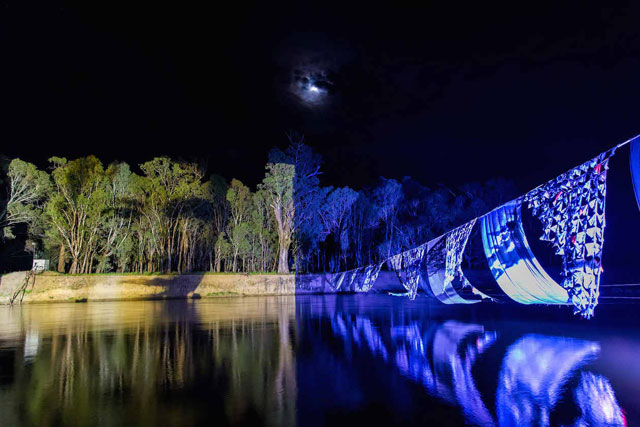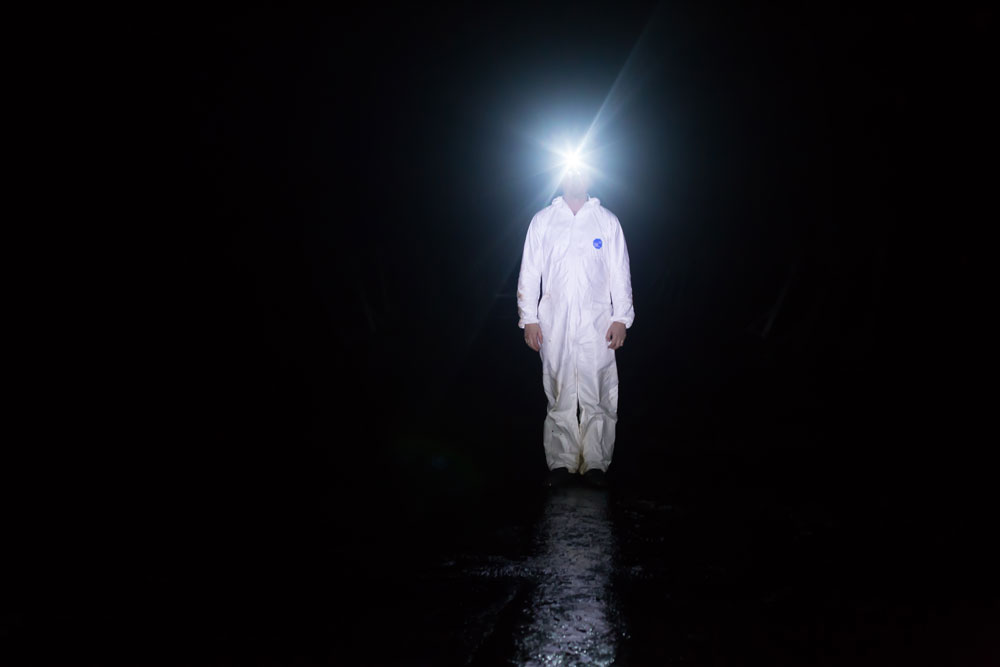
by JANET McKENZIE
Vic McEwan (b1972) is the artistic director of the Cad Factory, an innovative arts organisation based in regional New South Wales, Australia. He explores experimental and contemporary arts practice in partnership with diverse sectors, including hospitals. McEwan’s practice involves working with sound, video, installation and performance, with a particular interest in site-specific work. He has just returned from Tate Liverpool, where, in June, he was showing works in development from The Harmonic Oscillator, an artist-led project with Clive Parkinson, director of arts for health at Manchester Metropolitan University and Vicky Charnock, arts coordinator at Alder Hey children’s hospital in Liverpool.
For the collaborative project I Just Can’t Say That Word, McEwan is working with artist Mayu Kanamori, exploring her treatment and recovery from breast cancer. This work is seeing many outcomes, including compositions created entirely from medical scans.
I visited McEwan in his studio at Narrandera in New South Wales.
Janet McKenzie: What is the CAD factory and why have you chosen the remote western New South Wales town of Narrandera as your base?
Vic McEwan: The CAD factory is an organisation I run with my partner, creative producer and artist, Sarah McEwan. It started in Sydney in 2005 with an initial focus on music and monthly exhibitions in a warehouse, which was also our home. The ethos of the space was that we charged a small entry fee and 100% of that money went to the artists. The space was about celebrating the thriving artistic community that we were a part of.

Vic and Sarah – Image: Barbara Bartos and Vic McEwan - Cad Factory Artist Director Vic McEwan with Creative Producer Sarah McEwan in front of traditional burning techniques being trialled by Graham Strong, 2006.
JMcK: You play saxophone?
VMcE: I play many instruments, including piano, clarinet and guitar, but my focus has really shifted to an approach where I am trying to extract musicality from the functional infrastructure that we are surrounded by. By playing buildings, hospital infrastructure and other things, I am exploring the sonic materiality of the lived experiences of people within these places.
JMcK: Tell me more about that.
VMcE: It can take many forms. In 2015, I was artist in residence at the Museum of Australia [as the inaugural recipient of the Arts New South Wales Regional Fellowship] and, during that time, I created three large outcomes, working with curator George Main to explore Australia’s regional landscape and people’s relationships to these places. When I started the year-long residency, I asked to create a performance at the very beginning to “say hello” by sharing some of my practice. So, I ended up creating a performance where I placed contact microphones on one of the world’s oldest still-floating paddle-steamers, playing it as a musical instrument to an audience of 1,000 people as it sat moored on Lake Burley Griffin. Recently, I created a performance at Tate Liverpool, in which I used a hospital bed as a cello.
JMcK: You trained as a musician, then, rather than a visual artist?
VMcE: I didn’t train beyond initial music lessons. I sang in a church choir when I was young, then I had training in the bagpipes and the trumpet at school, and from there I was basically self-taught. At some stage, visual arts, music and performance merged for me. I started creating performances that involved my interest in music and visual arts. And now in my practice I find that, for example, the gallery-based work I create often has a very strong sound/music component. Likewise, if I am working outside on large site-specific works, which is a large part of my practice, I will be exploring ideas of sound, music, performance and visual arts within these projects.
I don’t see any separation between these things; they are all part of my creative process and ways in which to explore and share ideas.
Our move to regional Australia caused a big shift in our practice. The Cad factory was operating in Sydney until 2009, then we relocated to our regional base and very quickly became inspired by the landscape, the history and the people of this region, and so we started creating large artistic outcomes in that very landscape.
The property we live in – an old schoolhouse that was built in 1886 – cost us A$15,000 (£9,000) and since then we have built a large recording studio, artist’s accommodation and our own personal studios on the space.
JMcK: What is it about this landscape that makes it so different to even 100km east?
VMcE: When we bought the schoolhouse, we had no intention of living here. The intention was to set up an artist residency programme that needed no funding. We would give the space to artists for nothing, and they would come back and share with us what they explored during that time. We saw it as an extension of our community in Sydney. But very quickly we realised that us being in this space wasn’t about an extension of what we did in Sydney, it was about something new, it was about immersion in this landscape, it was about understanding this essential part of life, exploring the regional landscape that people are so reliant on for food and fibre production.
In our region, it is dry-land agriculture, but if you head just 50km west, you enter the Murrumbidgee Irrigation Area and, because of the massive irrigation infrastructure that has been built there, it is green with orchards, a completely different feel from our area. And then, as you travel further, you reach the Hay Plains, flat dry land that is used for various things including cotton farming. So we are in a nexus of changing landscape in this region, and it is part of what is so inspiring for us.

OCG Mary, the Moon and the River Hang – Image James Farley - On Common Ground – Haunting by Vic McEwan with George Main and Vanishing Point: Swan Hoppers Legacy by Julie Montgarrett with Clytie Smith and Vic McEwan. 2015
JMcK: Can you tell me about On Common Ground, the project that involved the Murrumbidgee river?
VMcE: On Common Ground was a project that we presented at Narrandera Common beside the Murrumbidgee river. At the heart of the project was the story of the “swan hoppers”. This region was once a breeding ground for swans, but with colonisation came the desire to stamp out parts of nature that were in man’s way. Local aboriginal communities had a system to manage the swan numbers, which enabled them to live in balance. Despite attempts by local aboriginal elders to advise on this type of management, the colonisers decided instead to employ people known as swan hoppers, whose job it was to walk along the banks of the river all day long, stamping on swan eggs with their boots. The amount of stink from egg yoke on your pants was a sign of how hard you worked that day.
Today, there are virtually no swans left on the river. On Common Ground was a large project that explored these ideas and aimed to acknowledge the common stories that we repeat through history while also trying to identify commonalities between people of different cultures or belief systems. We invited 19 local artists, seven visiting artists and 66 community members, including school students, to participate in a long process to create work along a 2km stretch of the river. We presented the work for three days and nights.
One work, made with artist Julie Montgarrett, was a large textile work that spanned the entire Murrumbidgee river, 100 metres wide. The work Julie created took several development periods over two years. We allowed time to dream about what the work could be before addressing the practicalities of installing such a large work, outdoors, over a river that was also something of a wind tunnel. Julie’ work explored, among other things, the story of the swan hoppers; other works in On Common Ground, explored many of the other species that no longer exist in this environment.
JMcK: Can you tell me about the work you have just shown at Tate Liverpool?
VMcE: I’ve been travelling to Liverpool for several years now, twice a year, as part of a project called The Harmonic Oscillator. It looks at research that tells us that sound levels in hospitals are having a negative effect on patients in terms of increases in medication, length of stay, stress, disturbed sleep and other things. No hospital has met the World Health Organisation’s recommendations of sound levels in a functioning ward. I had met Clive Parkinson from Manchester Metropolitan University and we had an appreciation for each other’s work and had been discussing these ideas since we met.
When I was awarded the Create NSW Inaugural Regional Arts Fellowship, it enabled me to travel to the UK to begin this project. Arts and health as a place of research and practice, was more established in the UK so it made sense to work there with the intention of bringing some of this experience and learning back to Australia.
One of the main reasons this project was so successful was that we didn’t have an initial pre-determined outcome in mind. It was more about what would be discovered if I were allowed the opportunity to be in this space, exploring this research and the lived human experience of patients, families and staff.
They did not expect me to make a particular kind of work, or make a work at all really. The first year and a half of travelling there was just being in the space and I was given amazing access, like spending nightshifts in wards or going to MRI scans with high noise levels. I’ve created hundreds of recordings and measurements of the sound space, discovering higher levels of noise in the hospital than the readings I was getting on a peak-hour bus in the middle of Liverpool.
There are six outcomes from this project now – the work is so rich. There was no pressure to have any outcomes and, as a consequence, it was more productive, more open to discovering outcomes that were relevant and born completely of this place and of this experience. So the project outcomes include an exhibition of interactive artworks, a radio documentary, a book by Clive Parkinson as he observed the process, an EP (an album of four compositions) created from the hospital space, an app for delivery in hospitals in Australia and the UK, and original research about sound levels in hospitals.
JMcK: What was exhibited at Tate Liverpool?
VMcE: During my time at Alder Hey children’s hospital, I would sometimes be working towards direct outcomes, and sometime letting the experience of the space direct what I was doing. Sometimes I worked with patients, making art. There was a patient who was highly agitated before surgery and it was suggested that I work with him. We went around the hospital measuring sound levels – where do he think the quietest part of the hospital was? And the loudest? It kept him occupied.
Having periods of time with patients was rewarding, trying to use art process, conversation and communication to help deal with the gravity of the situation, but not in the way that an arts therapist might.
So, at Tate, I created seven interactive artworks that were in development and on exhibition. For example, I met Elisha, a 17-year-old patient who had brought all her art journals in to hospital. She had collapsed at school, unaware that she was sick, and was found to have multiple cancers. The cancer had eaten part of her spine and she didn’t walk again after that collapse. We decided to work together as collaborating artists. Even as doctors decided her treatment wasn’t working, we continued to make some of the most profound work that I have ever been involved in.
JMcK: Are you trying to capture something of the reality and poignancy of mortality and dying?
VMcE: With this project, I was trying to capture something of the human experience of illness, from the position of the patient, the family and the staff. In essence, this must also include ideas of mortality and dying. My arts practice was present during the treatment, the recovery and even the death of patients. I am interested in how we navigate these immense experiences, and to be given that opportunity as an artist is something quite wonderful. I feel privileged to have been in that position. Sometimes it was pleasant, sometimes it was humbling, sometimes it was frightening, and sometimes it was just filled with sadness, but always it was filled with great artistic discoveries.
Elisha and I collaborated during my visits there. First, we made a video work using photographs she had taken of textures around her school and home – drain covers, bricks, leaves, bark. We then projected these on to her hospital bed, on to the white sheets, while she was still in the bed. We rephotographed these to make a short video work that really was about ideas of changing the barren landscape of the hospital ward to something that was filled with remembrance of home and remembrance of nature, and it allowed the hospital space to be transformed into something else.
Next, we started working with her internal body sounds. I taught her and her mum how to use a digital stethoscope and recording device and left it with them to do some recording together. I was also aware that, in the north of Scotland, near Inverness, there is a place where sound lasts longer than anywhere else on Earth. The reverb time in this space is an astonishing 112 seconds long. This has been scientifically measured using a gun firing blank bullets and calibrated sound-measuring equipment. The acoustic properties of this space have only recently been discovered: before then, the longest sound environment was thought to be in a mausoleum in Glasgow where sound lasted for just over 15 seconds.

Vic in Oil Tank – North of Inverness, deep inside the Inchindown Oil Tank, searching for the worlds longest reverb.
This space near Invergordon is a series of six interconnecting oil tanks that were built in secret, buried in the Highlands, between the first and second world wars in order to store enough oil that, if the ports were bombed, there was still enough oil to fuel the British Navy.
JMcK: There’s a lot of official secrecy in Scotland.
VMcE: It took a while to track down the owners of the oil tanks, as they are now on private property. But the idea to take a recording of a heartbeat that didn’t have long left to beat in this world, and to play it in the place on Earth where sounds lasts longer than anywhere else seemed astonishing. What would it mean to hear such a thing?
Elisha loved the idea that we would take her heartbeat to be played and rerecorded in this space. So I tracked down the owners, who were very helpful and obliging. Clive Parkinson and I travelled to the north of Scotland to climb inside this oil tank space, with no electricity and several packs of battery-powered equipment. To access the space, we had to walk down a 200m-long tunnel that went deep into the Highlands. We then had to be pushed through a 47cm wide pipe, a bit like a pizza oven.
JMcK: That sounds seriously bizarre.
VMcE: We pushed all our equipment in, in plastic bags. We had to be careful as the tank was empty but still had a coating of oil. We had to navigate the space with torches. When we first walked the length of the tunnel, it took about 40 minutes. After several hours, we had six microphones set up through the space and were ready to play the heartbeat and re-record it. When we played it, it was like a choir. The sound had movement. I felt as if I could see it moving around us, and as we listened to one single heartbeat ring out for two minutes. The experience was profound and moving. The owner of the oil tanks was moved and said: “The wee lassie’s heart beat is embodying the Highlands.” And it was true.
JMcK: There are many haunting places on Earth, but the Scottish Highlands are remarkable.
VMcE: My family is Scottish and I am the first in my family to be born in Australia. I have a strong interest in working there. To take the heartbeat to Scotland seemed very important. Its importance was in the creation of something profound and beautiful from this precious moment of the negotiation of life and death that Elisha was going through. It seemed important for the development of art form, of sound art, site-specific art and visual art. And somehow, given my own personal connection to Scotland, it seemed important to my own heritage.
JMcK: Can you explain the works you have made since On Common Ground and what links your various projects?
VMcE: The themes that seem to run through my practice are often ideas of exploring the trauma of lived experience and I do this in collaboration with people or communities who are undergoing or recovering from that trauma.
Traditionally, the art world has constructed its own hierarchy and, within this, we have seen the devaluing of art that engages deeply with people confined to the backwaters of community practice. But my practice claims this to be an outdated idea, and that if art is about exploring the human condition then the best way to do that is in collaboration – with people. Within my practice lies a process that is about both the engagement of the human experience and the development of contemporary art forms.
So my arts practice since On Common Ground has been focusing on areas of human wellbeing, of illness and recovery, of landscape and the environmental humanities – and, at the heart of all of this, are people.
I have recently completed a residency at Falls Creek [an Alpine ski resort in north-eastern Victoria, Australia] exploring a recently commissioned report that shows that, within three to five years, the snow season will be severely reduced as a result of climate change. How can I make art in this context, with this community, while exploring the emotional navigation of news that is in some ways abstract but, in actuality, is frighteningly real?
I have also been creating work with the National Museum of Australia’s specimen collection, exploring species loss as a result of colonisation.
I am now working on a project with friend and artist Mayu Kanamori. Mayu and I have collaborated off and on over the past 15 years and last year she called me to say she had been diagnosed with breast cancer. Mayu knew that I had been doing work in hospitals and she was interested in working together to explore her treatment and, hopefully, recovery and also her identity as an artist rather than a patient. From that initial conversation the project has moved along quickly and we have made several works together and spent two weeks in residence at the department of performance studies in Sydney, developing this work and sharing work in development with the arts and medical community.
JMcK: It’s a very privileged position both in the hospital and with Mayu.
VMcE: When Mayu first had surgery, she gave the hospital a letter that gave me permission to do anything artistically that I wanted to do with her body, in consciousness, unconsciousness, or even in death. Before her first surgery, I asked her to send me photos that had emotional significance for her. After her surgery, I was waiting in her room and, while she was still unconscious, I projected these images on to her and rephotographed them.
From that moment, we continued to make work during different stages of her treatment.
JMcK: It prompts the questioning of where the physical and spiritual and intellectual begin and end, and how they interact under the stress of illness.
VMcE: The blur and the fog of illness and the negotiations and decisions that are all a part of that are not the prime considerations of the doctors, whose job seems to focus on our “plumbing”, on our practical medical needs.
Among all the work with Mayu and my work in Alder Hey, come long and ongoing discussions about ethics and social responsibility. What can be shared? What can’t? It is an unknown area of exploration. Such as, how do I share work that has been made with a collaborator who has passed away? It is a complex journey that must be navigated gently.
My motivation for all this type of work is about allowing an emotional navigation that isn’t provided for in day-to-day existence. This is the value of the arts within these settings and also an opportunity for unique inspiration to allow genuinely contemporary and experimental artwork to take place.
JMcK: Thank you very much.